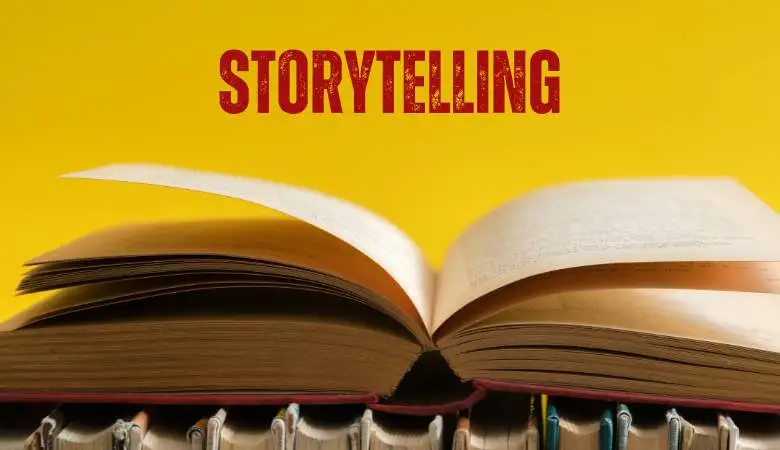Storytelling is a form of narration that aims to capture the audience’s attention and connect with them so that a message can effectively reach them.
This form of communication is also known as storytelling, and we can often see it defined as an art. This is because, in this practice, imagination and creativity are essential to building compelling storytelling.
The art of telling stories has existed since time immemorial, being a skill that characterized minstrels and troubadours, as well as writers and, later, screenwriters and journalists. But not only that, in advertising, professionals also realized that knowing what storytelling is and practicing it brought great benefits to a brand.
With storytelling, brands and digital marketing manage to appeal to the emotions of their target audience and create an unforgettable experience. Persuading the public, connecting emotionally with the audience, differentiating yourself from the competition, increasing brand awareness and attracting new customers are just a few.
Suppose you also want to introduce this art into your digital marketing strategy and, more specifically, your content strategy. In that case, you have come to a good end. In this article, we tell you everything about this form of communication, from the different types to the elements that good storytelling should have, including how to create your own step-by-step.
Types of Storytelling
Now that you know storytelling, it’s time to go deeper. You must understand that the art of storytelling can be transmitted in different formats and belong to very different genres. These differences mean that we can find various types of storytelling.
Storytelling according to its format
- Written narration uses text as a transmission format. It is the type of narration found in non-graphic novels.
- Oral narration is the oldest form of narration, and it is transmitted using only the voice. The purest examples are found in radio and music.
- Visual narration: it is perceived through sight but without using text. Therefore, an example would be painting and drawing.
- Mixed narration: there are not only pure narration formats, like the previous ones. We also find hybrid formats that combine two or three. For example, comics are a type of mixed narration in which written and visual narration are mixed. Cinema is an example of a combination of oral and visual narration, even in some cases, written narration.
The most common thing in digital marketing strategies is finding mixed narratives. However, since the boom in podcasts and audiobooks, it is increasingly common to see pure oral narration, which was lost due to the decline of radio.
Storytelling according to its genre
- A narrative can have a guiding axis or revolve around a theme. Depending on that, we can also find variants.
- Real personal narrative: the story revolves around a person’s real life. This type is widely used in marketing strategies, and we can see it when brands tell real user stories. It is also present when companies implement UGC (User Generated Content).
- Fictional narration: everything the story tells is not accurate but a product of the imagination. It is also widespread to find in advertising and marketing, especially in television advertisements or large campaigns.
- Historical narrative: The central theme is the past or evolution of an actual event. Companies often use this type of story to tell the public how they have evolved as a brand and to show the public that they are a severe and prosperous organization that adapts to the times. It is also used as part of an internal communication strategy so that teams value the company they work for more and increase their loyalty to it.
- Value storytelling: Storytelling focuses on telling the characteristics of something or someone. When companies implement it as part of their marketing strategies, they usually emphasize the benefits of their products or services.
- Product Storytelling—Storytelling focuses on what an object or activity is like. In marketing, the story revolves around how a product or service works.
Elements of good storytelling for marketing strategies
- There is a demand for the product or service you are promoting. If the goal of storytelling is to sell, the first thing is to ensure you are selling the right thing.
- They have a plot with a beginning, middle and end. Stories always follow a set of plot conventions, such as the hero’s journey, which makes them recognizable and easy for users to follow.
- They incorporate drama and tension to engage the audience. Conflict is the driving force of every story.
- They feature credible, nuanced characters, not just superheroes and supervillains.
- They are simple. You must have a single, unmistakable message to create a story that sells.
- They take place in a familiar environment. The stories that best connect with the audience are those they see themselves most reflected.
- They have an appropriate tone and style. The language and creative resources must be adapted to the brand’s values and the recipients: formal, informal, for adults, children…
- They are published in the proper context. Think of it as telling the customer’s story rather than your own.
- They come from a trusted company or brand. If not, users will not believe the message.
- They are consistent with the rest of your brand and marketing.
How to create stories that sell step-by-step
Storytelling is an art that requires creativity, vision, skill, practice, and a method. This step-by-step method, designed by Hubspot, will help you turn your ideas and brand messages into stories that sell.
1) Know your audience
Who might be interested in your story? Who will benefit and respond most? To create an engaging story, you have to understand your audience.
Before you start writing your story or script, take the time to research your target audience and buyer personas. This process will help you get to know the people reading, watching, or listening to you in depth so you can speak directly to them.
2) Decide what type of story you are going to tell and its purpose
The moment to decide the genre of your story. To make your choice easier, think about what your objective really is. That is, answer what you want to achieve with that story, apart from getting more sales or clients. Some genres than others depending on the story’s purpose purposely; if your goal is to make yourself known, historical narration can be an excellent idea since it works very well in these cases.
Conversely, if your goal is to educate your audience on a topic, value storytelling is the most appropriate approach.
However, this is not an exact science, and some genres suit different purposes. We encourage you to find your way.
3) Define your key message and include a call to action
It doesn’t matter if your story is 3 paragraphs, 10 pages, 20 seconds or an hour and a half.
There should always be a central message or slogan that stays in the audience’s mind.
It is also interesting that there is a CTA (call to action) that encourages the user to take the action we want.
4) Choose your format
Stories can be presented in many different ways. The format of your storytelling will depend on the type of story and the resources you can invest, for example:
In writing: Articles, blog posts or books with a combination of text and images. They are the most accessible way to start telling your stories.
By voice: In live presentations or through podcasts. This story format helps connect with the audience more emotionally, but it also requires more skill.
On video: With a traditional advertising spot or format designed especially for the internet. Although it requires more time and resources, this format is also one of the most effective for connecting with the audience and generating virality.
In digital format: This option allows us to combine multiple resources, such as text, video, animations or interactive elements. The sky is the limit!
5) Get to work
Write, record, photograph or tell your story.
6) Share your story
As always in content marketing, creating the story is only half the process, as it is essential to have a good dissemination strategy to reach as many people as possible. This strategy will depend on the format of the story and the channels used by your brand.




